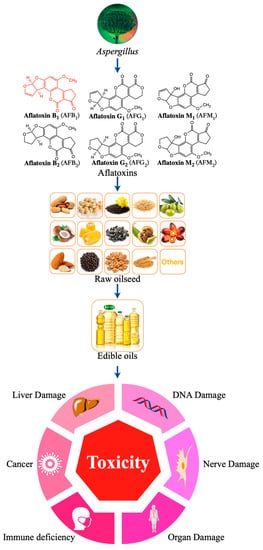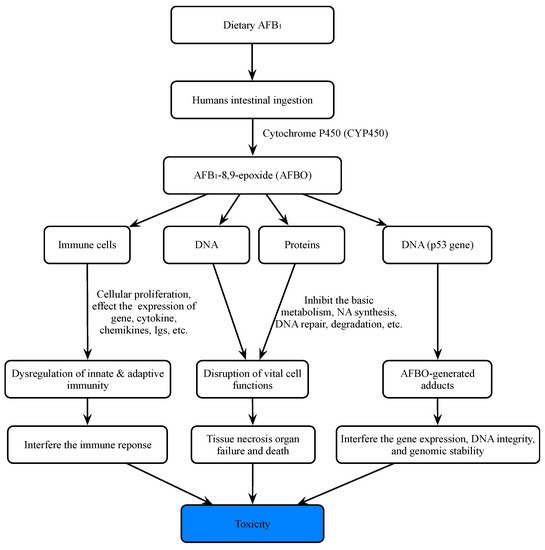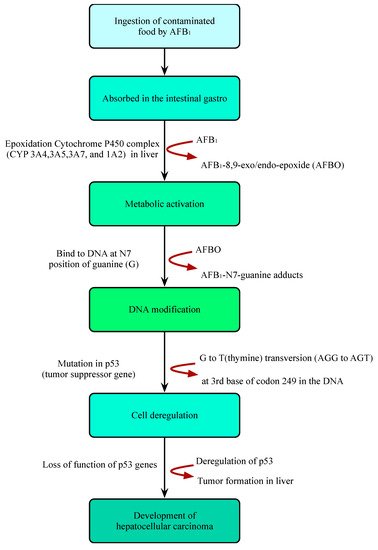You're using an outdated browser. Please upgrade to a modern browser for the best experience.
Please note this is a comparison between Version 1 by Yin Shipeng and Version 2 by Conner Chen.
Contamination of agricultural products and foods by aflatoxin B1 (AFB1) is becoming a serious global problem, and the presence of AFB1 in edible oil is frequent and has become inevitable, especially in underdeveloped countries and regions. As AFB1 results from a possible degradation of aflatoxins and the interaction of the resulting toxic compound with food components, it could cause chronic disease or severe cancers, increasing morbidity and mortality.
- aflatoxin B1
- edible oil
- chromatographic technology
- spectroscopic technology
1. Introduction
Food security has always been an issue of concern in the international community, and, in recent years, food contamination has become a major factor affecting food security. Contaminated food can not only adversely influence human health (poisoning events, chronic diseases, etc.) but also affect and slow down the economy. When people consume contaminated food, they need to spend a lot of money and time on treatment. There are many factors causing food contamination, such as biological, chemical, and physical factors. Among these, microbial contamination is common and mainly includes contamination by bacteria, fungi, molds, viruses, or their toxins and by-products [1][2][1,2]. Mycotoxins are common food contaminants, which can cause changes in the appearance, flavor, smell, and other characteristics of food [3][4][5][6][7][3,4,5,6,7]. Mycotoxins are secondary metabolites produced by fungi (e.g., Fusarium, Aspergillus, and Penicillium) that have multiple toxic effects on organisms and contaminate agricultural products (cereals, milk, etc.). More than 400 kinds of mycotoxins have been identified. Among them, aflatoxins (AFs) have become one of the major concerns due to their high toxicity and carcinogenicity, causing approximately 25% of animal deaths [8][9][10][11][12][8,9,10,11,12].
Edible vegetable oil plays an irreplaceable role in the human diet. The world oil crop output has increased year by year and had reached 635.5 million tons by 2021 [13]. From the growth of oil crops to the final product, i.e., oil, each link may be affected by external factors (such as mycotoxins), which may affect the quality and safety of edible vegetable oil [14]. This is because most oil crops, such as corn, peanut, soybean, rapeseed, sunflower seeds, olives, and nuts, are seasonal. During the growth process, they will be affected by climate, pests, and other factors and can be easily be infected by Aspergillus flavus. After harvest, the oil may deteriorate or be affected by mildew due to storage conditions (such as temperature and humidity, etc.) and storage methods [15]. At the same time, during the production of edible oil, fresh-pressed edible oil is vulnerable to contamination of raw materials infected with Aspergillus by aflatoxin B1 (AFB1) [16][17][18][19][20][21][22][16,17,18,19,20,21,22]. Therefore, contamination of edible vegetable oil products by AFB1 is a serious food safety problem (Figure 1) [20][23][24][25][20,23,24,25].

Figure 1.
Harmful effects of different types aflatoxins contaminated edible oil.
The presence of aflatoxin is usually detected by using precision instruments, such as high-performance liquid chromatography–mass spectrometry (HPLC–MS), high-performance liquid chromatography–fluorescence detection (HPLC–FD), or other molecular techniques, while rapid detection is mainly realized by enzymatic immunoassay ELISA [26][27][26,27]. Although different methods are available for the detection of AFB1 toxicity, these methods require expensive equipment and complex sample pretreatment or can only be performed at relatively high concentrations [28]. Therefore, simple, sensitive, efficient, economical, rapid, and stable AFB1 detection methods are required. Recently, new technologies, such as biosensors, have been applied in many fields, such as health care and food detection. Because of their key advantages, such as convenient operation, rapid response, and excellent portability, these technologies can detect harmful substances in food sensitively and accurately, helping effectively avoid their harmful effects. They have attracted increasing attention of researchers and also promoted the rapid development of biosensors. With progress in nanotechnology, scientists are paying special attention to biosensors based on nanomaterials. These new biosensors or detection systems are sensitive, rapid, consistent, and cost-effective and can be used to detect AFB1 in food [29][30][31][32][33][29,30,31,32,33].
2. Importance of Aflatoxins
Aflatoxins are a type of mycotoxins. They are highly toxic metabolites of fungi, produced in food and agricultural products. They have severe toxic effects, such as immunosuppressive, nephrotoxic, teratogenic, carcinogenic, and mutagenic, on human and animal health [34][35][36][37][38][34,35,36,37,38]. Aflatoxins can be divided into aflatoxin B1 (AFB1), aflatoxin B2 (AFB2), aflatoxin G1 (AFG1), and aflatoxin G2 (AFG2) according to their fluorescence properties and chromatographic mobility (Figure 1) [39][40][41][39,40,41]. Aflatoxin M1 (AFM1) and aflatoxin M2 (AFM2) are hydroxylated metabolites of AFB1 and AFB2, respectively. AFB1 is the most toxic among all AF species, with a high incidence rate and the most complex detection mechanism (Figure 2) [42].
Figure 2.
Main mechanisms of toxicity of aflatoxin B
1
for humans.

Figure 3.
Illustration of the mechanism of hepatocellular carcinoma caused by ingestion of AFB
1
-contaminated foods.
